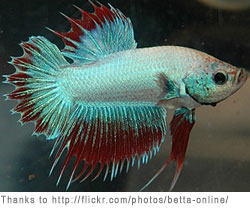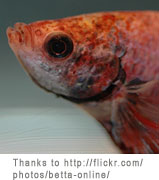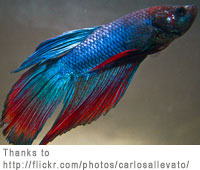Betta Fish Care

Betta fish are easy to care for
Origins of the Siamese Fighting Fish
They have specific requirements that are simple to meet so the betta fish or Siamese Fighting fish is perfect for the first time tropical fish owner. Betta fish originate from South East Asia and surrounding areas. They live and thrive in swampy habitats with poor water quality. You will find wild siamese fighting fish living in small puddles in swampland and jumping from puddle to puddle eating bugs that happen to fly over the surface of the water. They are solitary and if two males cross paths, they will often fight to the death. These fish have a life span of about 2-3 years. They are also called Siamese Fighting fish.Why do they live in small bowls?
Betta fish are labyrinth fish which means that they have specially designed breathing system that allows them to retrieve oxygen directly from the air instead of in the water like most other tropical fish, this makes them top-dwelling tropical fish. This is why they are perfect candidates for small bowls because they do not need air circulation and a high concentration of oxygen in the water. A Siamese fighting fish needs access to the surface of the water to get air.Siamese 'Jumping' Fish
An important and often overlooked tip for proper betta fish care is to have the fish bowl covered. As mentioned before, Siamese fighting fish jump from stream to puddle in the wild and the same is true for the captive ones, they jump! If you do not cover your bowl, one day you will eventually see your siamese fighting fish dried up or flopping about your floor! Be sure to have a gap between the lid and the surface of the water because they need to access the top of the water to breathe air. Always leave at least a half of inch space between the surface of the water and the lid of the bowl. Be sure the lid has air holes so it does not suffocate.
Maintenance of the Betta Bowl
Betta fish care requires a 1/2 water change every week or two. Simply remove half the water and replace it with de chlorinated water that is the same temperature as the water in the bowl. There are two ways to replace the water: Firstly, you can use a thermometer to pour water the same temperature as currently in the bowl and add dechlorinator to the water and then top up the bowl. Another way is to leave water sit out overnight. The temperature will gradually adjust to be the same temperature as in the bowl and the chlorine will evaporate.Once a month, you want to rinse out the gravel or substrate at the bottom to remove fish waste and leftover food because they will eventually rot, increasing the amount of ammonia on the water and eventually killing your it. Dump the water from the bowl into a smaller container that has the volume of half of the bowl, keep pouring until the Betta has been dumped out into the other container. Stir up the water in the bowl so that the fish waste floats out from the gravel, swish it around and dump out the remaining water. You want to swish the old water around to 'rinse the gravel' because if you wash out the gravel with tap water, the chlorine will kill the beneficial bacteria that lives on the gravel and will shock the fish, increasing the risk of disease or death. If you need to rinse the gravel because of an excess waste buildup, do it with de chlorinated, cool water. Hot water will also kill the beneficial bacteria and cause epoxy coated colored gravel to flake. Fill up the newly cleaned bowl with de chlorinated water that is the same temperature as the container with the siamese fighting fish, and return your betta into his home.
Watch those fins!
One word of caution and an important tip in betta fish care is to never use a fish net to catch a Siamese Fighting fish when doing water changes because their fins are very delicate and can easily get caught in the fiber of the net and be ripped, causing damage and stressing the betta. This is why we recommend to pour the water and the betta fish into the other container, this is the easiest way to move this species of fish from one container to another.